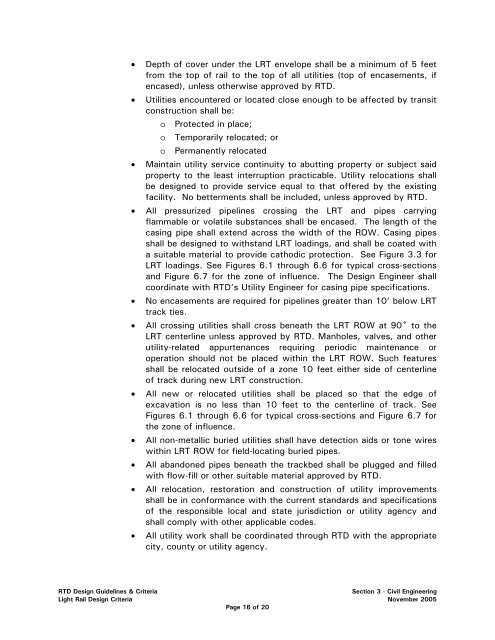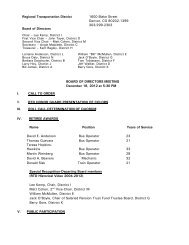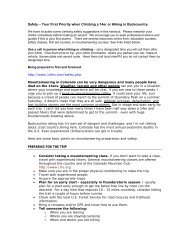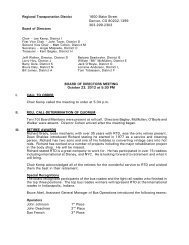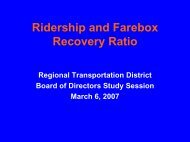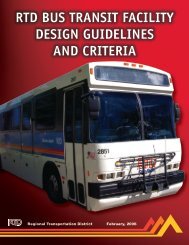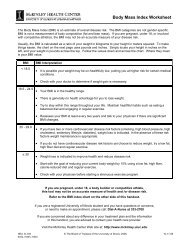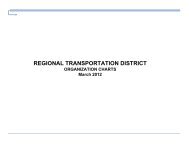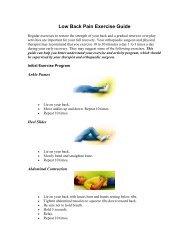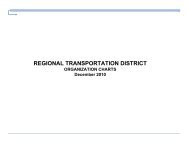RTD Light Rail Design Criteria
RTD Light Rail Design Criteria
RTD Light Rail Design Criteria
Create successful ePaper yourself
Turn your PDF publications into a flip-book with our unique Google optimized e-Paper software.
• Depth of cover under the LRT envelope shall be a minimum of 5 feet<br />
from the top of rail to the top of all utilities (top of encasements, if<br />
encased), unless otherwise approved by <strong>RTD</strong>.<br />
• Utilities encountered or located close enough to be affected by transit<br />
construction shall be:<br />
o Protected in place;<br />
o Temporarily relocated; or<br />
o Permanently relocated<br />
• Maintain utility service continuity to abutting property or subject said<br />
property to the least interruption practicable. Utility relocations shall<br />
be designed to provide service equal to that offered by the existing<br />
facility. No betterments shall be included, unless approved by <strong>RTD</strong>.<br />
• All pressurized pipelines crossing the LRT and pipes carrying<br />
flammable or volatile substances shall be encased. The length of the<br />
casing pipe shall extend across the width of the ROW. Casing pipes<br />
shall be designed to withstand LRT loadings, and shall be coated with<br />
a suitable material to provide cathodic protection. See Figure 3.3 for<br />
LRT loadings. See Figures 6.1 through 6.6 for typical cross-sections<br />
and Figure 6.7 for the zone of influence. The <strong>Design</strong> Engineer shall<br />
coordinate with <strong>RTD</strong>’s Utility Engineer for casing pipe specifications.<br />
• No encasements are required for pipelines greater than 10’ below LRT<br />
track ties.<br />
• All crossing utilities shall cross beneath the LRT ROW at 90˚ to the<br />
LRT centerline unless approved by <strong>RTD</strong>. Manholes, valves, and other<br />
utility-related appurtenances requiring periodic maintenance or<br />
operation should not be placed within the LRT ROW. Such features<br />
shall be relocated outside of a zone 10 feet either side of centerline<br />
of track during new LRT construction.<br />
• All new or relocated utilities shall be placed so that the edge of<br />
excavation is no less than 10 feet to the centerline of track. See<br />
Figures 6.1 through 6.6 for typical cross-sections and Figure 6.7 for<br />
the zone of influence.<br />
• All non-metallic buried utilities shall have detection aids or tone wires<br />
within LRT ROW for field-locating buried pipes.<br />
• All abandoned pipes beneath the trackbed shall be plugged and filled<br />
with flow-fill or other suitable material approved by <strong>RTD</strong>.<br />
• All relocation, restoration and construction of utility improvements<br />
shall be in conformance with the current standards and specifications<br />
of the responsible local and state jurisdiction or utility agency and<br />
shall comply with other applicable codes.<br />
• All utility work shall be coordinated through <strong>RTD</strong> with the appropriate<br />
city, county or utility agency.<br />
<strong>RTD</strong> <strong>Design</strong> Guidelines & <strong>Criteria</strong><br />
Section 3 - Civil Engineering<br />
<strong>Light</strong> <strong>Rail</strong> <strong>Design</strong> <strong>Criteria</strong> November 2005<br />
Page 16 of 20


